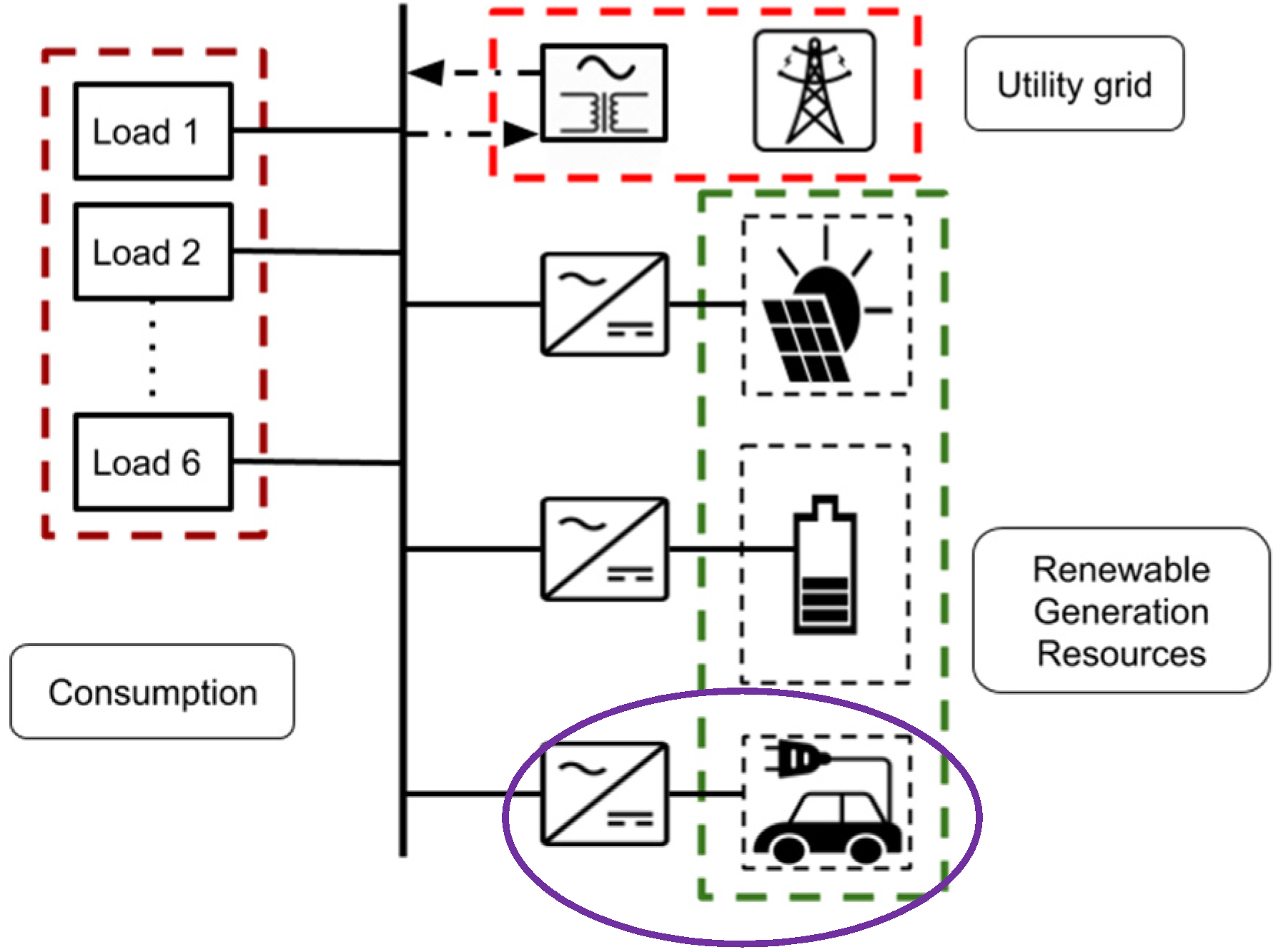The Impact of e-Mobility in Positive Energy Districts †
Abstract
:1. Introduction
2. Material and Methods
3. Results
4. Discussion of Results
- Only scenarios where energy efficiency in buildings is reasonably good (labelling system A or B) achieve positive energy balance with a varying number of EVs.
- Scenarios where buildings are labelled as B can generate up to 7899 kWh energy surplus when using LED lighting and no EVs. This energy could feed around 400 EVs (1 year under Spanish kms usage) and have a positive annual energy balance of 87 kWh.
- Scenarios where (all six) buildings are labelled as A (new constructions) will generate around 10,855 kWh annual energy surplus, or in other words, can meet the mobility demands of 550 EVs, which represents more than 1.8 million green km.
5. Conclusions
Author Contributions
Conflicts of Interest
References
- C2ES. Global Emissions: Center for Climate and Energy Solutions. 2016. Available online: https://www.c2es.org/content/international-emissions/ (accessed on 14 July 2021).
- IEA. Global CO2 Emissions by Sector, 2018—Charts—Data & Statistics—IEA. 2020. Available online: https://www.iea.org/data-and-statistics/charts/global-co2-emissions-by-sector-2018 (accessed on 14 July 2021).
- Kristin, S.; Sverrisson, F. Renewables 2016 Global Status Report; REN21: Paris, France, 2016; ISBN 978-3-9818107-0-7. [Google Scholar]
- European Technology Platform SmartGrids. SmartGrids SRA 2035 Strategic Research Agenda Update of the SmartGrids SRA 2007 for the needs by the year 2035. In Smart Grids European Technology Platform; European Union: Mestreech, The Netherlands, 2012; p. 74. Available online: https://www.etip-snet.eu/wp-content/uploads/2017/04/sra2035.pdf (accessed on 19 July 2021).
- Bossi, S.; Gollner, C.; Theierling, S. Towards 100 positive energy districts in europe: Preliminary data analysis of 61 European cases. Energies 2020, 13, 6083. [Google Scholar] [CrossRef]
- Moreno, A.G.; Vélez, F.; Alpagut, B.; Hernández, P.; Montalvillo, C.S. How to Achieve Positive Energy Districts for Sustainable Cities: A Proposed Calculation Methodology. Sustainability 2021, 13, 710. [Google Scholar] [CrossRef]
- Pearson, P.J.G.; Foxon, T.J. A low carbon industrial revolution? Insights and challenges from past technological and economic transformations. Energy Policy 2012, 50, 117–127. [Google Scholar] [CrossRef] [Green Version]
- Fichera, A.; Pluchino, A.; Volpe, R. Modelling energy distribution in residential areas: A case study including energy storage systems in Catania, Southern Italy. Energies 2020, 13, 14. [Google Scholar] [CrossRef]
- Howell, S.; Rezgui, Y.; Hippolyte, J.L.; Jayan, B.; Li, H. Towards the next generation of smart grids: Semantic and holonic multi-agent management of distributed energy resources. Renew. Sustain. Energy Rev. 2017, 77, 193–214. [Google Scholar] [CrossRef]
- Uimonen, S.; Lehtonen, M. Simulation of Electric Vehicle Charging Stations Load Profiles in Office Buildings Based on Occupancy Data. Energies 2020, 13, 5700. [Google Scholar] [CrossRef]
- Rodríguez, L.R. Achieving Energy-Efficient Districts: Contributions through Large-Scale Characterization and Demand Side Management. Ph.D. Thesis, University of Seville, Seville, Spain, 2018. [Google Scholar]
- Towards 100 positive energy districts in Europe: Preliminary data analysis of 61 European cases.
- Fichera, A.; Pluchino, A.; Volpe, R. Local Production and Storage in Positive Energy Districts: The Energy Sharing Perspective. J. Front. Sustain. Cities 2021, 3, 1–11. [Google Scholar] [CrossRef]
- Castillo-Calzadilla, T.; Fessler, S.; Borges, C.E.; Andonegui, C.M. Urban district modelling simulation-based analysis: Under which scenarios can we achieve a Positive Energy District? In Proceedings of the 2021 18th International Multi-Conference on Systems, Signals & Devices (SSD), Sfax, Algeria, 22–25 March 2021; pp. 1107–1114. [Google Scholar]
- Ministerio para la transición ecológica y el reto demográfico. Boletín Oficial del Estado; Real Decreto 1183/2020; Ministerio Para la Transición Ecológica y el Reto Demográfico: Madrid, Spain, 2020; p. 124893.
- Instituto para la Diversificación y Ahorro de la Energía (IDAE). Calificación de Efficiencia Energética de Edificios; IDEA: Madrid, Spain, 2009. [Google Scholar]
- Instituto Nacional de Estadística. Km Medios Recorridos al año por los Vehículos para uso Personal, por Relación con la Actividad Económica de la Persona de Referencia y Antigüedad del Vehículo; Instituto Nacional de Estadística: Madrid, Spain, 2008. [Google Scholar]
- Instituto para la Diversificación y Ahorro de la Energía (IDAE). Consumo y Emisiones de CO2. Vehículos Nuevos. 2016. Available online: http://coches.idae.es/consumo-de-carburante-y-emisiones (accessed on 19 July 2021).

| Scenario | PV | ESS | Lighting | EVs | Energy Label |
|---|---|---|---|---|---|
| 1 | Yes | Yes | LED | No | C |
| 2 | Yes | Yes | LED | No | B |
| 3 | Yes | Yes | LED | Yes | B |
| 4 | Yes | Yes | LED | No | A |
| Scenario | PV | ESS | Lighting | Energy Label | EVs | Annual Balance (kWh) | PED |
|---|---|---|---|---|---|---|---|
| 1 | Yes | Yes | LED | C | No | −2134 | No |
| 2 | Yes | Yes | LED | B | No | 7899 | Yes |
| 3 | Yes | Yes | LED | B | Yes | 87 | Yes |
| 4 | Yes | Yes | LED | A | No | 10,855 | Yes |
Publisher’s Note: MDPI stays neutral with regard to jurisdictional claims in published maps and institutional affiliations. |
© 2021 by the authors. Licensee MDPI, Basel, Switzerland. This article is an open access article distributed under the terms and conditions of the Creative Commons Attribution (CC BY) license (https://creativecommons.org/licenses/by/4.0/).
Share and Cite
Castillo-Calzadilla, T.; Alonso-Vicario, A.; Borges, C.E.; Martin, C. The Impact of e-Mobility in Positive Energy Districts. Environ. Sci. Proc. 2021, 11, 24. https://doi.org/10.3390/environsciproc2021011024
Castillo-Calzadilla T, Alonso-Vicario A, Borges CE, Martin C. The Impact of e-Mobility in Positive Energy Districts. Environmental Sciences Proceedings. 2021; 11(1):24. https://doi.org/10.3390/environsciproc2021011024
Chicago/Turabian StyleCastillo-Calzadilla, Tony, Ainhoa Alonso-Vicario, Cruz E. Borges, and Cristina Martin. 2021. "The Impact of e-Mobility in Positive Energy Districts" Environmental Sciences Proceedings 11, no. 1: 24. https://doi.org/10.3390/environsciproc2021011024
APA StyleCastillo-Calzadilla, T., Alonso-Vicario, A., Borges, C. E., & Martin, C. (2021). The Impact of e-Mobility in Positive Energy Districts. Environmental Sciences Proceedings, 11(1), 24. https://doi.org/10.3390/environsciproc2021011024









